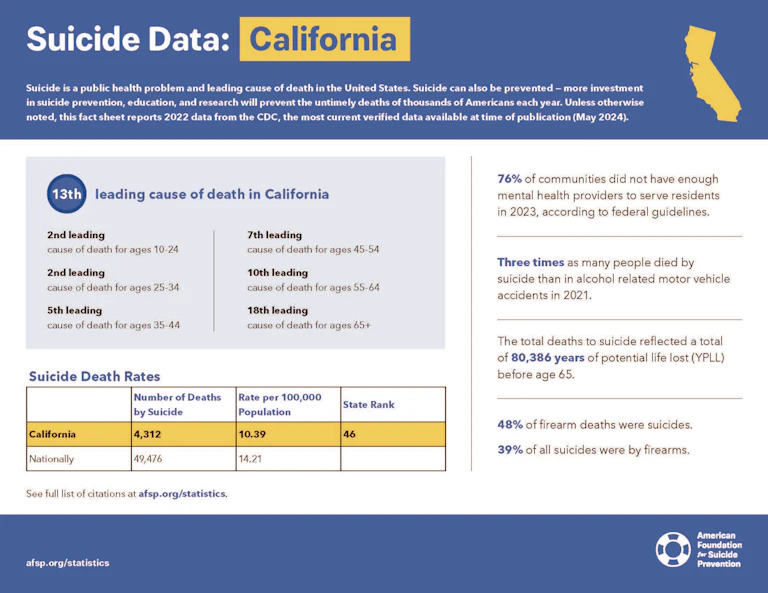California
California suicide prevention plans and initiatives
The California Department of Public Health’s (CDPH) Injury and Violence Prevention Branch (IVPB) was awarded a Comprehensive Suicide Prevention Program cooperative agreement in September 2020 by the Centers for Disease Control and Prevention's (CDC) National Center for Injury Prevention and Control (NCIPC) in order to implement and evaluate a comprehensive public health approach to suicide prevention, with attention to vulnerable populations.
In 2018, the Mental Health Services Oversight and Accountability Commission (MHSOAC), created in 2004 by the Mental Health Services Act, was directed by the legislature to update and improve upon the state’s 2008 suicide prevention plan. A Suicide Prevention Subcommittee was formed to lead the initiative, and in 2019 the Commission adopted Striving for Zero: California’s Strategic Plan for Suicide Prevention 2020-2025. In 2020 the legislature authorized the State Department of Public Health to establish the Office of Suicide Prevention (OSP) to coordinate suicide prevention efforts statewide, requiring the Office to consult with the MHSOAC to implement efforts consistent with Striving for Zero; see OSP’s Year 2 Highlights brief.
California laws
Key:
- Required by law
- Encouraged by law
- No law in place
Crisis lines and 988 implementation
- Addresses 988 infrastructure and provides for telecom user fee
- Addresses 988 infrastructure but does not include telecom user fee
- 988 law limited to creating an exploratory commission, advisory committee, or task force
Mental health parity
- Public health plans (e.g., Medicaid) regularly submit parity compliance analyses to state regulators
- Private health plans (individual and group) regularly submit parity compliance analyses to state regulators
K – 12 school suicide prevention
- Inclusion of the 988 Suicide & Crisis Lifeline and/or other crisis line(s) on student ID cards
- Student allowances for excused mental health absences
- School personnel must report student suicide risk to a parent and/or guardian
- Suicide prevention and/or mental health training for certain school personnel, annual
- Suicide prevention and/or mental health training for certain school personnel, not annual
- Suicide prevention, intervention, and postvention policies/programming
- Student education on suicide prevention
- Student education on mental health
Health professional training in suicide assessment, treatment and management
- Mental health professionals receive regular training
- Mental health professionals receive one time training
- Medical/surgical professionals receive regular training
- Medical/surgical professionals receive one time training
Conversion therapy bans
- Prohibits licensed/board certified mental health providers from engaging in conversion therapy with minors under 18 years of age
- Prohibits licensed/board certified mental health providers from engaging in conversion therapy with vulnerable adults
- Prohibits use of state funds for any purpose related to conversion therapy (e.g., conducting, making a referral for, or extending health benefits coverage for)
University and college campus suicide prevention
- Inclusion of the 988 Suicide & Crisis Lifeline and/or other crisis line(s) on student ID cards
- Students receive information on available mental health and/or suicide prevention services and/or resources
- Adoption of suicide prevention/awareness policy or program
